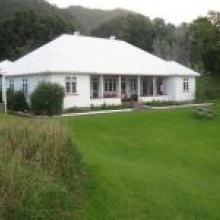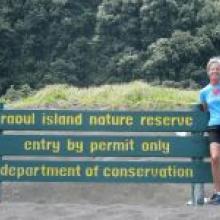But the reality of most trips to the northernmost New Zealand-controlled territory is a far cry from your usual island holiday.
Wanaka couple Stu and Heather Thorne travelled the 1100km to Raoul, the largest of the Kermadec Islands, not to put their feet up, relax, or unwind but to volunteer as part of a regular Department of Conservation programme.
The pair embarked on a five-day boat trip from Auckland in March to reach Raoul Island, which would be their home for the next six months.
Arriving on the island involves a harrowing final drop-off at the Raoul landing "rock", where the Thornes had to negotiate rough seas to jump ashore from a landing boat on to a narrow rocky outlet.

Awaiting them was a rigorous schedule of maintenance programmes, which included track-clearing and hut maintenance, weed-eradication work, and biosecurity control duties.
The Thornes acknowledge the hard work might not be everyone's cup of tea, but the chance to visit one of New Zealand's most remote and least-known island outposts was an opportunity not to be missed.
The couple are regular visitors to the wild mountain routes of the Southern Alps, and as keen trampers, they certainly fit the bill for Raoul volunteers, which calls for a high level of fitness, agility and flexibility, and general field skills.
An added attraction of visiting Raoul was the chance to visit Mr Thorne's brother Ian, who is stationed as the Doc team leader on the remote island.
For Stu, who retired from a lifetime of working for Doc in Wanaka in February, volunteering on Raoul meant he was able to tick off one of the last island outposts of New Zealand he had not visited.
Mr Thorne has made many trips to Doc-administered islands to the south of New Zealand, but the trip to the northern island was a totally different experience.
"It's got such lush, tropical vegetation, which you'd expect.
"It's warm all the time, the birdlife is great, and it is so different to the cold, windswept landscapes of New Zealand's southern offshore islands."
The remoteness of Raoul hit home for Mrs Thorne and made her think about existence on a wider scale.

However, the "dot" was also home to some fascinating landscapes, birdlife, beautiful beaches, sealife, and some "unforgettable experiences", Mrs Thorne said.
A work schedule was structured so that tasks were carried out on Mondays, Tuesdays and Thursdays, leaving plenty of time to explore the island, she said.
The options for the adventurous were certainly varied, with a choice of climbing the rugged slopes of Raoul's Moumoukai Peak, which rises 516m, visiting the island's isolated white-sand beaches, bathing in seaside hot pools, and staying overnight in remote huts.
Visits to Denham Bay, where a shipwrecked Korean trawler lies beached, were a "spectacular" highlight, as was a trip to the island's two active volcanoes, the Thornes said.
Denham Bay is named after one of the first Europeans to visit the islands, Captain M. H. Denham, who landed on Raoul in HMS Herald on July 2, 1854.
During the visit, Capt Denham's 16-year-old son, Fleetwood James Denham, died from a tropical fever.
Fleetwood was buried back from the main beach, where several grassy graves of former settlers can also be found.
One of the island's volcanoes, located near the bay, is also named after Capt Denham.
A second volcano on Raoul, in the north of the island, contains three crater lakes, and has a legacy which echoes the untimely death of Capt Denham's son.
In 2006, Doc worker Mark Kearney was killed in an eruption as he carried out water-temperature tests at a crater lake.
Staff of the island were evacuated at the time.
The island remains an earthquake-prone active zone.
The Thornes say the volcano and crater lakes form an "otherworldly" landscape, where a sulphurous stench permeates the air, while eerie leafless trees, exposed rocky craters and brightly coloured lakes dominate.
The three crater lakes have temperatures which range from 23degC up to "boiling point".
The deep-sea trench is like an ocean highway for migrating whales, and it also contributes to the vast array of sealife in the area, which is one of the world's largest protected marine reserves.
Snorkelling the waters around Raoul was "fantastic".
The volunteers were also involved in a whale-monitoring exercise which allowed them to get up close and personal with the giants of the deep.
Mr Thorne said they counted 160 humpback whales during a single four-hour monitoring stretch, held at the peak of the migration season.
"There were whales breaching everywhere.
"An unbelievable number of them," Mr Thorne said.
Despite the abundance of sealife and because of the archipelago's marine reserve status, fish "definitely" remained off the menu.
Raoul Island was declared predator-free in 2002, after goats were first eradicated in 1986 and then cats, rats and stoats.
A programme to eradicate rats from other islands in the Kermadec group is ongoing.
The Thornes say Raoul Island is a habitat which is "really unique", while their six-month internships as voluntary workers meant an escape from "normal, real" life; something to which they had been adjusting since they returned to Wanaka in October.
"It's just so different to anywhere else.
"We're so pleased we got to go, and feel really privileged," Mrs Thorne said.
"It is a vulnerable place and to be a part of something which is working towards preserving the island is fantastic.
"The weeding programmes are working, biosecurity measures have been successful, and you can see the effects it is having on the native plants and birdlife.
"It is really important to keep all that going.
About Raoul:
• Raoul Island is the largest of the Kermadec Islands, an archipelago which is surrounded by New Zealand's largest marine reserve, created in November 1990.
• The marine reserve is large, even by world standards, at about 7450sq km.
• The islands are about 1000km northeast of New Zealand and are the most remote conservation area managed by the Department of Conservation.
• Raoul Island Station is manned by a team of Doc staff and volunteers, who carry out programmes such as weed-clearing and biosecurity control, roading and track maintenance, and monitor a weather station.
• The 30sq km island has two active volcanoes containing three caldera lakes. In 2006, Doc worker Mark Kearney was killed when a crater lake erupted as he conducted water-temperature tests.



